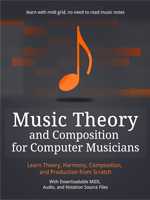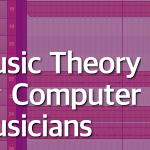Welcome to “Music Theory for Computer Musicians” course – this free course will teach you the basics of music theory using MIDI software, yay! Please be aware, this guide was originally written as a book, thus you may encounter phrases such as “in this book” throughout the series.
 Update 2nd of February, 2021: this series of tutorials is free, but I took all of them, and expanded them greatly into a book. The book is nearly three times as big; there are more source files, and a lot new images with traditional notation; an entire parts on music production and music composition. This free series of tutorials you’re reading right now will remain free and it will teach you the basics of theory, but if you like it, I encourage you to get the full book :).
Update 2nd of February, 2021: this series of tutorials is free, but I took all of them, and expanded them greatly into a book. The book is nearly three times as big; there are more source files, and a lot new images with traditional notation; an entire parts on music production and music composition. This free series of tutorials you’re reading right now will remain free and it will teach you the basics of theory, but if you like it, I encourage you to get the full book :).
Anyway, this course explains the basics of music theory for people who want to produce music on a computer. I don’t mean electronic music specifically, like trance or other genres of EDM, but generally music made on a computer using DAW programs (Digital Audio Workstations) and MIDI editors that allows us to create melodies and harmonies and use virtual instruments. There are few classic notes in this course, and a lot of MIDI editor screenshots, so those who do not read music notation nor want to learn it can still learn how to make music using graphical interface. Hopefully, my English skills are good enough to explain everything as simple as possible.
Who Is This Book For
First of all, I wrote this guide for those readers who do not know music theory, but who want to learn. Whether you want to:
- Create music to create accompaniment for your own vocals;
- Compose your own uplifting trance;
- Or create soundtracks for games;
- Or do any other sort of music;
This guide is for all soon-to-be computer musicians. Learning the basics of music theory is very important if you want to create your own music. So I write this guide to beginners, first. That said, I also suggest you read other books about music theory, because… well, I will be honest, I’m not that great with music theory, which can be a very complex subject. But I know enough to create my own music, and I believe there aren’t too many books that teach music theory from computer musician and MIDI perspective, so here we are. That said, I recommend reading other books, too, such as Music Theory for Dummies (aff), because reading two or three books about music theory one after another is a great way to start! This is exactly what I did.
There’s also a great free website, musictheory.net, which offers classic education with notes and staff and general music notation.
The second group of readers I hope to help with this book are people who already know music theory because they’ve learned it through traditional means (like books, courses, schools), and right now they just want to see how the things they know are represented in DAW programs and MIDI editors.
Beware!
Let’s be honest – this guide might be boring. Music theory books usually are. And teaching music theory through books is difficult – especially if you’re a non-native speaker.
With music theory books, you learn words, terms and concepts – but they can be a bit abstract until you start composing and applying these things in practice. Since there is no real practice in this book, you may feel weird after reading everything I wrote here. I know the feeling, it’s exactly the thing I felt after reading a couple of music theory books myself when I was a stiill beginner.
It’s this feeling that makes you ask, “But how the heck do I compose music?” Music theory books usually do not answer this question and to keep things simple, I decided to stick to this tradition and leave composition for another guidebook (you may notice that music education is often divided into music theory, music composition and music harmony).
There will be many terms and concepts and pictures here in this book, and in the end you may still have no idea what you’ve just read :). Music theory is more about learning words and concepts, like learning a new language – after learning it, you can read other books in this language and understand what others are talking about.
So don’t worry if you feel weird and things still aren’t clear – once you get into practice with my other guidebooks; or books, courses and tutorials made by other people, things will become a lot more clear.
The Software You Need
Before you read on, you should start with installing proper software on your computer: that is a DAW program with a MIDI editor, that will allow you to open all the files for this book (downloaded separately).
DAW: Digital Audio Workstation
DAW stands for Digital Audio Workstation – it’s a type of program used by everyone who work with some kind of audio. DAW programs allow you to compose music, edit audio, create new sounds (sound design) and so on.
There are many of such programs available these days. Personally, I use Reaper. It doesn’t look like much, and it’s very spartan in its design, but behind the simple looks, it’s a very capable piece of software.
You can download it here:
- Reaper – http://reaper.fm
It offers a free trial version that you can use for free for 60 days. Then, you need to purchase a license, which is quite affordable, like only 60 dollars for personal and small business use.
Other two DAW programs that you may want to try are:
- Cubase – https://www.steinberg.net/en/products/cubase/start.html
- FL Studio – https://www.image-line.com/flstudio
They’re a bit more expensive, but still very popular. There are many more DAWs on the market these days, but these three are what I recommend. DAWs offer various functions, but most of their functionality is all the same – meaning that all DAWS share similar functionality such as tracks creation, MIDI editors and so on. If you’re unsure which one to choose, then go for Reaper – it’s free for 60 days and that’s enough to learn the basics of music theory.
Virtual Instruments
To make music in a DAW program, you also need virtual instruments. Let’s learn some basic stuff about them and learn how to use them in general. Virtual instruments come in two forms:
- A library of instruments with “patches” that are loaded in to a sampler.
- Stand-alone VSTi programs.
These instruments are either synths that use your CPU power to synthesize sounds, or “sampled” real instruments that use real recordings and computer code to simulate realistic sounds.
Instrument libraries are collections of files loaded into a “sampler” – another program that can work as stand-alone, or as a plugin loaded into a DAW. There are a few samplers on the market, such as EastWest’s Play engine, Best Service’s Engine, or the most popular one, Kontakt by Native Instruments.
You can download it here:
- Kontakt 6 Player – http://www.native-instruments.com/en/products/komplete/samplers/kontakt-6-player/
This program is free and there are also free libraries and instruments you can find on-line. It also comes with a free library, Factory Selection, in which you can find pianos, such as Ragtime Piano patch, which may be useful when reading this book and learning. The only limit is that unofficial instruments will work only for 15 minutes in this free version.
The full version of Kontakt 6 costs about 400 dollars and allows you to use a lot more libraries and instruments. But you don’t need this for the purpose of this book.
Kontakt has its own installer and works both on Mac and Windows, often automatically adding its own plugin version to your DAW. After successful install, you can open your DAW, add Kontakt as a plugin and add an instrument to use.
There are non-Kontakt instruments, as well. On Windows, they often come in form of .dll files. They are loaded directly as plugins into your DAW. An example of such instrument is the DSK Music’s “The Grand”, which works both on Windows and Mac (it has a different extension on Mac, not a .dll).
- The Grand – http://www.dskmusic.com/dsk-the-grand/
It’s a free instrument that you can install on your hard drive by pasting the downloaded file into a folder with all your VST plugins. Then you can use this instrument as a plugin directly in your DAW. It’s a good solution for people who just want to start learning without spending money on any instrument. Usually, instruments like this can be downloaded as RAR or ZIP package that you need to unpack, and then move the files to VST folder on your computer.
Sometimes you may need to add a path to an instrument in your DAW manually, so the DAW can then scan the folder and make the plugins available for use. Usually, you need to open the folder containing the plugin and copy this folder’s path into proper settings area of your DAW.
Read the manual for your DAW as well, because a lot of DAWs comes with a basic synth instrument that you can use right away.
Final tip: do not fall into a trap of buying software and instruments all the time. Start small and try to stick with free software or trial versions at first, and see if music production is something you wish to pursue further.
Download Files
I have prepared a ZIP package for this guide that you can download separately from a link below. The package contains MIDI files that you can open in your DAW and listen or edit yourself to learn music theory in a more practical manner.
- Download free files for this course (6.1 MB from Dropbox)
Inside the package, you’ll find audio files and MIDI files. The MIDI files have a .MID extension. Please note they do not have any audio stored, just data. This means they contain notes and by themselves, they make no sound. You need to add an instrument to a MIDI track to actually hear anything.
If for whatever reason the links to files attached to this book stop working in the future, and you’ve purchased a paperback (which can’t be edited), I will use my Social Media channels to point everyone to the place where the files are located. If such case, I’m sorry for the inconvenience, but one way or another, as long as this guidebook is being sold, the files will be available, even if this means you have to ask me where they are :).
Don't forget to become a fan on Facebook and subscribe to new posts via RSS or via email.






